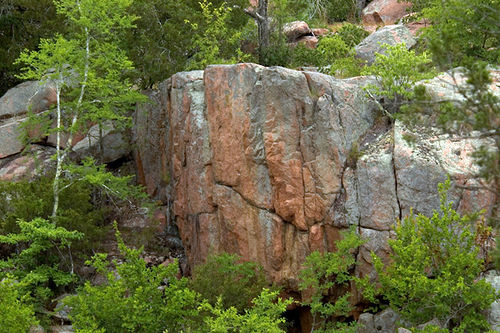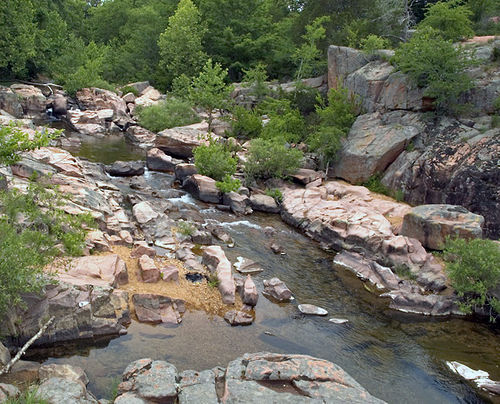Thursday I thought I would try the Castor Shut-Ins, see if the overcast days would help with the photographs. The challenge with taking photos in Missouri is the unusual coloration of much of the environment here–all that pink because of the iron deposits in the state.
Overcast and cooler but still humid at the Shut-Ins. This was the first time I’d been in this area since Winter, and it’s amazing how different it is with the seasons. In the winter, all is open and light. In the Summer, though, the leaves close in and the hills are full of shadows.
It’s difficult to describe to those unfamiliar with the types of forests in this area what it’s like being deep in the woods in the Ozarks in the summer. Most guidebooks recommend saving the trails for the fall, spring, or winter. They say it’s because of the bugs and the heat, but I can’t see how this, alone, is enough to discourage the avid hiker. I think it’s the heaviness of life that surrounds the hikers that intimidates.

Walking through the trees on Thursday, I was reminded of the passage from the old short story, Windigo by Algernon Blackwood:
The forest pressed round them with its encircling wall; the nearer tree-stems gleamed like bronze in the firelight; beyond that — blackness, and so far as he could tell, a silence of death. Just behind them a passing puff of wind lifted a single leaf, looked at it, then laid it softly down again without disturbing the rest of the covey. It seemed as if a million invisible causes had combined just to produce that single visible effect. Other life pulsed about them — and was gone.
The creature seemingly at the heart of this story is a variation of the legendary Windigo: spirits of humans who out of desperation and madness, turn to eating other humans to survive. As punishment they are made into a creature, tall, fearsome, and hungry for flesh–a Canadian werewolf, since the Windigo is primarily a Canadian legend. It is just one of the many creatures of legends that are said to populate the dense stands of trees in wilder forests–when we peer in among the woods and can’t quite see what is making that shape, or what caused a bush to shudder.
The Ozarks where I walked on Friday are said to be the habitat of the Ozark Howler, a very large and heavy black cat that roams the hills, emitting a blood-curdling howl. It’s eyes are said to glow yellow, it stands three feet high at the shoulder and, according to one ‘experienced Ozarks huntsman’, the ‘numerous’ sightings have shown us that without a doubt the creature does exist.
Well, without a doubt until you see the name of the leading Ozark Howler investigator: Itzakh Joach.
Unlike the woods of the shadowy north, east, or west, the Ozarks have never had a fearsome reputation. No monsters stalking the unwary hunter; no restless spirits. Not even the animal life is that inimical to humans, but more on that later.
At Amidon Conservation Area, where the Castor Shut-Ins are located, I met an older couple leaving as I came in. Since mine was the only car in the parking lot, I assumed I was the only one about. Aside from the usual squirrels and birds, it was quiet–not even a little wind to stir the leaves and the humidity.
At the section where the dirt trail moved on to the rocks, I noticed that the end of one of the dead trees was shredded and torn apart. Though this is a good indication that a bear had been in the area, how fresh was the damage was hard to determine.
There was hardly any water running in the stream over the Shut-Ins; as wet as it has been up here in St. Louis, the southern part of the state is going through a drought. Still, it was uncomfortably humid as I walked about the rocks. I followed the trail down to the stream bottom, but stopped about half way–tired, cranky, and dripping with sweat.

Every once in a while I’d hear sounds from back down the trail — twigs breaking, movement in the bushes. I actually stopped walking a couple of times to listen more closely, and expected to see more hikers arrive, but no one joined me at the rocks.
I decided not to do the full loop, which would take me through too much brush. When I headed back I noticed fresh scat in the path by the torn apart tree. (For you city folk, ‘scat’ is a polite term for animal shit.) This pile of scat was very distinctive: one of Missouri’s rare black bears had come, and gone, while I’d been exploring the rocks.
I had a mixed feelings, seeing that scat. I was disappointed the bear wasn’t there at the trail, and realized I may have frightened him or her away into the bushes near the water. At the same time, and even knowing that no human has ever been threatened much less attacked, by a black bear in Missouri, I froze like a deer in headlights. I had to walk through the forest, about half a mile, to get to my car. My nice, safe car.
An interesting albeit stilted half-mile, too. I’d walk for a little ways, slowly and deliberately, and then hear a noise and freeze, grabbing for my camera (to take a picture, or somehow use as a weapon, I wasn’t quite sure). If all was still, I’d start walking again, head rigidly kept to the front, eyes fixed on the trail.
My nervousness was largely unjustified, as black bears are a timid, non-aggressive animal. Though they can reach up to 400 pounds, the ones we usually encounter range between 100 and 200 pounds. If you startle one they might ‘slap’ at you, but unlike a big cat, a black bear slap will usually only tear your clothes and scratch you. You can even be near their cubs, and chances are they won’t react negatively unless they feel you are a direct threat. Serious black bear attacks rarely happen because of accidental meetings, defense of young, or because of fear.
However, black bears have attacked and killed people–dozens in the last century, several in the last five years. There’s no rhyme or reason to what causes a normally timid creature to turn predatory. What’s worse, is that a black bear that’s a killer is a stalker–deliberately stalking the person, and then moving in for the kill.
Most of our fears of the woods have to do with being stalked by the unseen. Knowing that our dull human senses can’t detect that which can smell our fear, watch our stumbling steps. In the Stephen King Book, The Girl Who Loved Tom Gordon, a young girl is lost in the woods of Maine and struggles to survive the elements and lack of food and clean water. As she stumbles along, she is stalked by a creature, the thing in the woods she comes to think of as the God of the Lost, a creature with long, spiky teeth, half seen clawed paws.
Boom! Thunder woke her. Crack! Lightning, right overhead. And rain, lashing down. The most violent storm Trisha had ever seen. She struggled to her feet, gathered her stuff, blundered toward the rusted-out cab, and as her hand touched the door, she saw it: A slump-shouldered huge something poised across the road, with great cocked ears like horns. The God of the Lost, waiting in the rain.
In the woods, lost or no, one’s fancy grows as long as the shadows cast by the trees in the afternoon light–a fact that is sheepishly self-evident once we’re back in our nice aluminum cars, air conditioning cooling heated cheeks, and slugging down water from a plastic bottle. We pack the terror in the woods out with us, along with the rest of our trash.
I’m disappointed that I couldn’t get my picture of a black bear. Seeing fresh evidence is exciting, but not as exciting as having a picture of a Missouri black bear. I have an idea, though, where I might be able to get a bear photo this fall and will continue my quest. In the meantime, this will be last hike for the summer in the Ozark wilds. Not because of the bear: because of the heat and the humidity, the omnipresent poison ivy, and the nasty bug bites I have on my legs.


